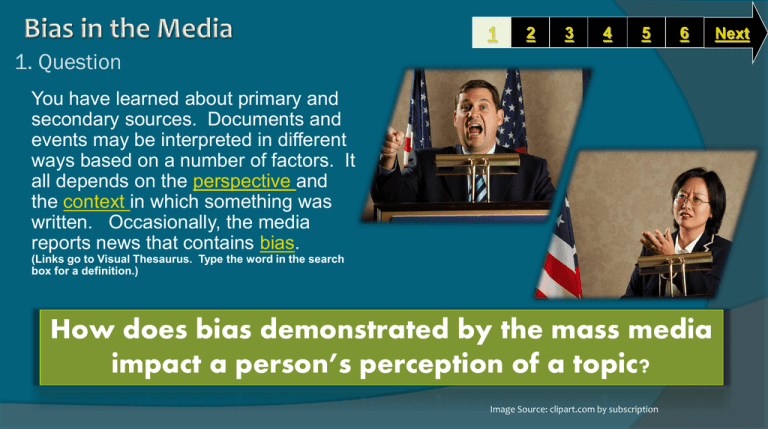
1
2
3
4
5
6
1. Question
You have learned about primary and
secondary sources. Documents and
events may be interpreted in different
ways based on a number of factors. It
all depends on the perspective and
the context in which something was
written. Occasionally, the media
reports news that contains bias.
(Links go to Visual Thesaurus. Type the word in the search
box for a definition.)
How does bias demonstrated by the mass media
impact a person’s perception of a topic?
Image Source: clipart.com by subscription
Next
2. Information Sources
1
In an ideal world, historians and
reporters would not demonstrate
bias in their articles. They should
present all of the facts without giving
Media
their personal opinion on an issue.
sources
Many people get their information
include
through many sources of media. It television,
is the goal of media news to remain newspapers
and
unbiased.
2
3
4
5
6
Next
Image Source: clipart.com by subscription
magazines
Can you identify the different forms
of bias in the media? Review this
reading and then test your
knowledge.
Image Source: http://www.worldbookonline.com/student/article?id=ar291220&st=forms+of+mass+media&sc=1
3. Student Activity
Determine how bias has
evolved over the years by
reading the article “Media
Bias” Read using the SQ3R
Strategy.
In order to see how the
headline may not always
match the story, test your
knowledge by completing
Heads Up Headlines.
1
2
3
4
5
6
Next
Media
may be
digital
or in
print
form
Image Source: clipart.com by subscription
4. Assessment Activity
1
2
3
4
5
6
Next
Now that you know about the types of bias and how media bias may be
portrayed, it’s time to challenge your knowledge. Your teacher will give you
a topic. Your task is to find two articles on the same topic. You will try and
identify specific types of bias in the article.
It is suggested that you begin your search for articles using the BCPS
Online Databases, specifically NetTrekker and Opposing Viewpoints. You
may also find information on news websites. Suggested sources include
Reuters or the Associated Press.
Write a letter to the publisher of the newspaper or website. The letter
should include the following:
Title of the article and the author/reporter/historian
Specific examples of bias found (remember to use the vocabulary terms
from slide 2)
At least 2 suggestions the writer could do to make the article free of bias.
Specific examples of how bias in the article will impact your view on a
topic.
Scoring Tool
Video of Brian
Williams reporting
on the CBS News
Scandal where
bias was
demonstrated.
Image Source: nbclearn.com by subscription
5. Enrichment Activities
1
2
3
4
5
6
Examples of Media Bias… Do you agree
that the media may be biased? What are
your thoughts? See what others think
about the media.
President Clinton Accusing Fox News of
Bias Video
CBS staff fired over media bias Video
What is Media Bias? Article
First Lady Bush talks about bias in Iraq
War reporting Video
Image Bias Game
Image Sources Dumas, Ernest C. "Clinton, Bill." World Book Student. World Book, 2012. Web. 26 July 2012., Curtin, Michael. "Cable News Network (CNN)." World Book Advanced. World Book, 2012.
Web. 26 July 2012. Gordon, Rich. "Journalism." World Book Advanced. World Book, 2012. Web. 26 July 2012.. Curtin, Michael. "Television." World Book Advanced. World Book, 2012. Web. 26
July 2012., "Bush, Laura Welch." World Book Advanced. World Book, 2012. Web. 26 July 2012.
Next
6. Teacher Support Materials
BCPS Curriculum
7th Grade KSI-D, evaluate bias in mass media coverage of the Arab-Israeli conflict
8th Grade Students will examine the concept of history in order to draw conclusions regarding
its role in interpreting the human past.
Maryland State Curriculum
7.5.C.1. Analyze the major sources of tension and conflict in the contemporary world
7.1.B.1. Analyze the methods used by individuals and groups to shape governmental policy
and actions
7.1.B.2. Analyze the importance of civic participation as a citizen of the world
7.2.B.1. Analyze how diverse cultures shape a pluralistic society
7.5.C.1. Analyze the major sources of tension and conflict in the contemporary world
R1.3.4 Uses understanding of the meaning, coherence, validity, and relevancy of ideas to guide
comprehension and make connections within and across texts.
Common Core State Standards
Reading: 1. Read closely to determine what the text says explicitly and to make logical
inferences from it; cite specific textual evidence when writing or speaking to support conclusions
drawn from the text.
Writing: 7. Conduct short as well as more sustained research projects based on focused
questions, demonstrating understanding of the subject under investigation.
Standards for the 21st Century Learner
1.1.6 Read, view, and listen for information presented in any format (e.g. textual, visual, media,
digital) in order to make inferences and gather meaning.
2.1.3 Use strategies to draw conclusions from information and apply knowledge to curricular
areas, real-world situations, and further investigations.
Maryland Technology Literacy Standards for Students
3.0: Use a variety of technologies for learning and collaboration.
1
2
3
4
5
6
Time Frame: Two 50 minute class periods
Differentiation:
Direct students to use comprehension tools included
in databases, such as: audio read-aloud, labeled
reading levels, and embedded dictionaries.
Teachers may choose articles ahead of time for
students based on reading level and content.
Learning Styles: Visual, Auditory, Global Understanding
and Analytical.
AVID Strategies: SQ3R Reading Strategy
Notes to the teacher:
1.
Teachers must pick topics prior to instruction for
students to find newspaper articles about. This may
include an election, global disputes, reform movements,
wars/conflict, discrimination and product advertisements.
2.
Students should have prior knowledge about primary
and secondary sources.
Last updated: July 2012
Created by Karen Yelito Social Studies Department Chair and Library Media Intern
BCPS Slam Dunk Research Model, Copyright 2012, Baltimore County Public Schools, MD, all rights reserved. The models may be used for educational, non-profit school use only.
All other uses, transmissions, and duplications are prohibited unless permission is granted expressly. This lesson is based on Jamie McKenzie’s Slam Dunk Lesson module.





